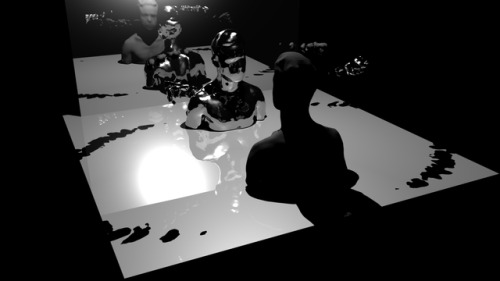#minded motion

Day 1 and 2: After getting to know the work of all artists involved and the research projects of Motion Bank, we devised questions around ways to incorporate networked interaction for intersection between dance and webrtc technology. We looked into researching tools and different kinds of configuration for networked collaboration and performances. One idea that come up was to find ways to erase the line that splits the screen/space for a more dynamic interaction and approach. Here, we thought to provide users with features that can enhance the experience in a collaborative format while still maintaining the idea of performance as being a product of the process,that is, through the trajectory of creating, documenting and viewing.
Day 3: Daniel and I began our research by looking at possible inputs and outputs that any user would like to have available in order to establish a direct line of communication with other performing and creative technical artists whom are collaborating at a distance.
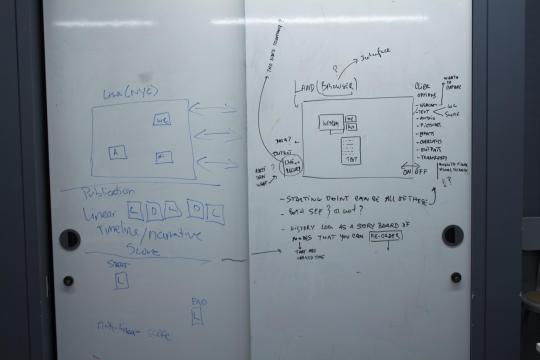
Our first exploration involved visual outputs as a representative documentation of the interaction. Olivia Jack created a webrtc slit-scan program: http://ojack.github.io/slit-scan/
The program records two users/performers moving together and outputs a visually abstract recording that fragments time in various increments (real time, slow and reverse) for the duration of the performance. The speed can be controlled by the each user.
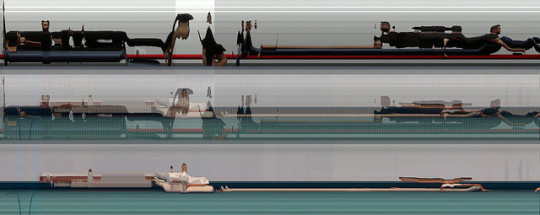
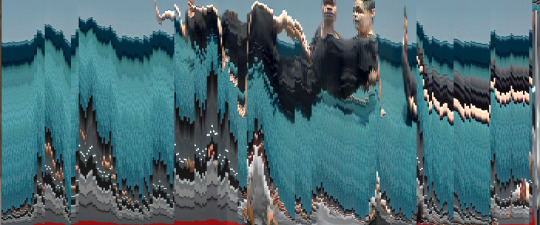
After exploring the slit-scan outcome, we realized that this program could be useful as a type of final representation of a networked performance, or movement experience. However, we thought to explore more the idea of blurring the online spaces to create a more physical/embodied interaction.
Olivia Jack then created a webrtc program called Portals: http://ojack.github.io/portals/
The program allowed us to “move together” allowing for more creating input by each user
Here Olivia (Bogotá), Lisa and Daniel (NYC) experimented moving together using Portals:
Another exploration, this time playing with light and movement (Oliva, Lisa and Daniel):
Day 4/5: In the final days and preparation for our showing, we took our experimentations of using the webrtc slit scan and portals to understand how the networked environments can be reconfigured and adapted to include more bodies, and to include an audio score to direct performers.
We collaborated with Kate Sicchio* to include her project, which involved 10 audio scores. The scores were triggered by data received from solar wind. The data is updated every minute triggering various verbal scores. The dancer/performer moves according to which scores is being dictated from the real time solar wind data.
For the final presentation we used Kate’s audio scores for performers in Bogotá (Colombia), New York (USA) and Porto (Portugal) to make a network dance/performance.
Notes/Reflection:
Here are some thoughts and reflections that arose from the experiences held while participating with LAND PROJECT at the CCL 4. Our group included Lisa Parra Daniel Pinheiro and Olivia Jack. During this time we experimented with three webrtc programs: opentok, slit scan and portal. We then shared our process with others in the group to extend our discoveries and online practice to a community of dancers and programmers to play with and explore.
Two outcomes from CCL 4:
1. Create different visual output possibilities for a networked embodiment experiences for documentation and archiving.
2. Develop a layout for communication and interaction between remote locations for collaboration and performance.
Both of these outcomes included our originally research for this project. In the last year we began using an open-source (webrtc) based platform called opentok. Opentok became ‘meeting point’ for artists to use as online space– open atelier or rehearsal space. We then introduced different inputs and outputs to visually generate and combine material that is automatically recorded and archived as it happens giving more choices to artists for possible post comments and documentation.
Although LAND PROJECT is a relationship between two distinct artists, we are interested in exploring ways to materialize our process and methodologies as a model for others to 'interact’ and share in the process itself.
Opening the process to others and combining it with the work of Olivia Jack and Kate Sicchio was definitely an important step towards an understanding of the use of these tools as a model for artistic practices. The embodiment of the other in the case of LAND PROJECT happens when the communication is established. The screen is definitely a barrier to overcome, like many other barriers that separate people. However, here the communication layout created brought many people together to interact and dance with each other. The participants, in this case, did not need to look at one another in order to feel each other’s presence. In this performance there were four location: in New York, the “green hallway” an open space that began with two performers, but throughout the performance had various people join the two original dancers; another more intimate spaces in New York was the ‘audio room’ where two males performed the scores. Other locations included performers from Portugal and Colombia. In these locations, the performers participated from a living room in one and a bedroom in the other. Language also played an important role, as not all participants understood English very well. All four locations created a performative situation linked together by sound and the internet. Here, the understanding of time and environment is where both the participant and spectators can witness the different locations and draw a multilayered narrative where ‘users’ become spectators of themselves even though they’re interacting with a group of people distributed across different time-zones and spaces.
The participation of Daniel Pinheiro in this edition of the CCL was made possible with the support of The Luso-American Development Foundation.
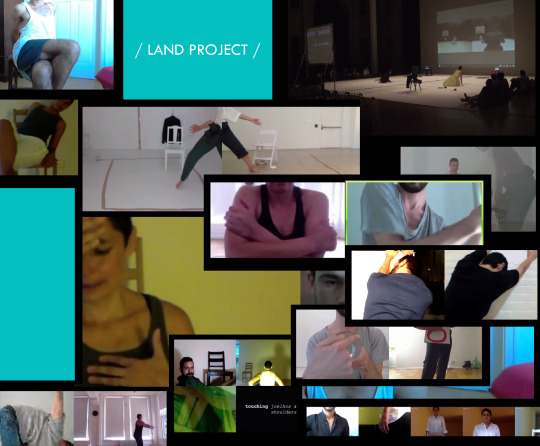
landproject has been selected to participate in this years 4th Choreographic Coding Lab - CCL #4. The lab will take place in New York City and will be hosted in partnership with ITP department of the Tisch School of the Art at New York University.
During this time Lisa Parra ( lanaisnotwool ) and Daniel Pinheiro* ( daniel-pinheiro ) will be working in collaboration with artist Olivia Jack(rhizomaticode ). We will be developing on the webrtc interface for approaching different ways to understand the space of the screen for collaborating at a distance and the possible inter-action.
More information on this will be updated using our twitter account: @LAND_PROJECT // and @motion_bank
CCLs are an outcome of Motion Bank, a four-year research project of The Forsythe Company focused on the creation of on line digital scores with guest choreographers.
*The participation of Daniel Pinheiro in this edition of the CCL was made possible with the support of The Luso-American Development Foundation.
Hyperspace is a completely hybrid and promiscuous space where everything is intermingled and networked with everything else, a space where cultural and territorial markers have been deleted, a space marked by a total lack of distance. (…) Of course, the internet certainly has elements of hyperspace and speeds up global hyperculturization. Culture in a classic sense disappears in what is, so to speak, more cultural than culture, namely in hyperculture and in reality: as Baudrillard would put it, it disappears in what is more real than real, namely in hyper-reality. #electronicpanopticon (Byung-Chul Ha)
LAND PROJECT moves forward questioning the strong sense of everything that lacks or, in fact, moves at the rhythm of how the internet shapes the identity of a relationship based on encounters and discussions, a relationship that is lit every time onliness happens and pulls the time and space in between.
Readmore
I find it interesting that the context of the internet is what has created and shaped our relationship. There is this paradox of you being a stranger yet at the same time a close friend, that is. something more than just a collaborator. The rhythm of how we work and move together is also interesting within the notion of ‘feeling present’– I know that you are there even when you are not. (Lisa)
Aside from what drives both artists to keep interacting together, while other ideas come in to the conversations, there’s a constant movement of the bodies in relation to each other. A remote entanglement between two particles in the same stream of consciousness where the intersection of juxtapositioning flow of the natural organic coding between two human entities occurs. Out of the repetition, the meaning and significance changes every time. And in the development of an enduring system of mediated communication, the possibility of performativity of a process that loops into a continuous transformation.
it’s about the impossibility of dealing with the untranslatable and its affections… (Daniel)
The different setups that materialize, also, this project to audiences and other participants (see Performeando and Online Cooking) are fragments of an established set of guidelines that are resultant from a specific environment shaping this connection.
Ultimately, opening up the rehearsals towards an unknown, unnamed, or undefined object that contains the essence of what the connection is made of is always in relation to how two bodies place themselves in front of each other and striving to feel one another.
check our page TIMELINE:PROCESS
“what does it mean being human in the future?” “how to be seen?” “the in between as a potential for connection…” the constant transformation caused by a state of permanent transition was present in Eli Steffen’s questions for his curation of Gray Spaces @ the Wild Project, as part of the Contemporary Performance Network Festival, Special Effects.
While addressing some of these questions in our work, this version of LAND PROJECT / Placelessness (first developed in residence in October, 2015) took on the following premise: negotiating movement within the in-betweeness of the digital space, as a response to one of the themes of Gray Spaces - the uncharted topographies of performance.
Where are you when you’re not here?! Where is here…?
Land Project, performed by Lisa Parra and Daniel Pinheiro, gave us some video-mirroring between Lisa in the lobby and Daniel on a live feed from an undisclosed location, presumably backstage. Physical movement was benign, but there was an eerie ISIS quality to Daniel’s placeless dark room. The physical became vocal as characters spoke in different languages, struggling to communicate and comprehend. “Are you here now? Where is here?”

